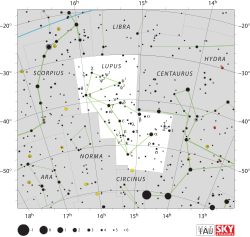Xi1 Lupi
| Observation data Epoch J2000.0 Equinox J2000.0 (ICRS) | |
|---|---|
| Constellation | Lupus |
| Right ascension | 15h 56m 53.49808s[1] |
| Declination | −33° 57′ 58.0129″[1] |
| Apparent magnitude (V) | 5.114[2] |
| Characteristics | |
| Spectral type | A3 V[3] |
| U−B color index | 0.069[2] |
| B−V color index | 0.116[2] |
| Astrometry | |
| Radial velocity (Rv) | −10.0±4.2[4] km/s |
| Proper motion (μ) | RA: +23.27[1] mas/yr Dec.: −37.85[1] mas/yr |
| Parallax (π) | 23.60 ± 3.48 mas[1] |
| Distance | approx. 140 ly (approx. 42 pc) |
| Details | |
| Mass | 2.01[5] M☉ |
| Luminosity | 12[6] L☉ |
| Surface gravity (log g) | 4.14±0.14[5] cgs |
| Temperature | 9,206±313[5] K |
| Rotational velocity (v sin i) | 78[5] km/s |
| Age | 237[5] Myr |
| Other designations | |
| Database references | |
| SIMBAD | data |
Xi1 Lupi (ξ1 Lup, ξ1 Lupi) is a probable binary star[8] in the southern constellation of Lupus. It is faintly visible to the naked eye with an apparent visual magnitude of 5.1,[2] and forms a visual double star with Xi2 Lupi. Based upon an annual parallax shift of 23.60[1] mas as seen from Earth, it is located around 140 light-years from the Sun. It is a member of the Upper Scorpius sub-group of the nearby Sco OB2 association.[9]
This star shows periodic radial velocity variations that can be best explained as a spectroscopic binary system.[8] The visible component is an A-type main-sequence star with a stellar classification of A3 V.[3] It has twice[5] the mass of the Sun and shines with about 12[6] times the Sun's luminosity from its outer atmosphere at an effective temperature of 9,206 K.[5] The star is an estimated 237 million years old and is spinning with a projected rotational velocity of 78 km/s.[5]
References
- ^ a b c d e f van Leeuwen, F. (2007), "Validation of the new Hipparcos reduction", Astronomy and Astrophysics, 474 (2): 653–664, arXiv:0708.1752, Bibcode:2007A&A...474..653V, doi:10.1051/0004-6361:20078357, S2CID 18759600.
- ^ a b c d Slawson, Robert W.; Hill, Robert J.; Landstreet, John D. (September 1992), "A homogeneous catalog of new UBV and H-beta photometry of B- and A-type stars in and around the Scorpius-Centaurus OB association", Astrophysical Journal Supplement Series, 82 (1): 117–144, Bibcode:1992ApJS...82..117S, doi:10.1086/191711.
- ^ a b Levato, H. (January 1975), "Rotational velocities and spectral types for a sample of binary systems", Astronomy and Astrophysics Supplement Series, 19: 91–99, Bibcode:1975A&AS...19...91L.
- ^ de Bruijne, J. H. J.; Eilers, A.-C. (October 2012), "Radial velocities for the HIPPARCOS-Gaia Hundred-Thousand-Proper-Motion project", Astronomy & Astrophysics, 546: 14, arXiv:1208.3048, Bibcode:2012A&A...546A..61D, doi:10.1051/0004-6361/201219219, S2CID 59451347, A61.
- ^ a b c d e f g h David, Trevor J.; Hillenbrand, Lynne A. (2015), "The Ages of Early-Type Stars: Strömgren Photometric Methods Calibrated, Validated, Tested, and Applied to Hosts and Prospective Hosts of Directly Imaged Exoplanets", The Astrophysical Journal, 804 (2): 146, arXiv:1501.03154, Bibcode:2015ApJ...804..146D, doi:10.1088/0004-637X/804/2/146, S2CID 33401607.
- ^ a b McDonald, I.; et al. (2012), "Fundamental Parameters and Infrared Excesses of Hipparcos Stars", Monthly Notices of the Royal Astronomical Society, 427 (1): 343–57, arXiv:1208.2037, Bibcode:2012MNRAS.427..343M, doi:10.1111/j.1365-2966.2012.21873.x, S2CID 118665352.
- ^ "ksi01 Lup". SIMBAD. Centre de données astronomiques de Strasbourg. Retrieved 2017-03-08.
- ^ a b Antonello, E.; et al. (January 2006), "Probable nonradial g-mode pulsation in early A-type stars", Astronomy and Astrophysics, 445 (1): L15–L18, arXiv:astro-ph/0511491, Bibcode:2006A&A...445L..15A, doi:10.1051/0004-6361:200500216, S2CID 15557098.
- ^ Brown, A. G. A.; Verschueren, W. (March 1997), "High S/N Echelle spectroscopy in young stellar groups. II. Rotational velocities of early-type stars in SCO OB2", Astronomy and Astrophysics, 319: 811–838, arXiv:astro-ph/9608089, Bibcode:1997A&A...319..811B.
